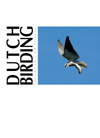Dutch Birding volume 28 (2006) no 3

Dalmatian Pelican and Great White Pelican in the Netherlands in June 1975-October 1976
On 25 June 1975, an adult Great White Pellican Pelecanus onocrotalus and an adult Dalmatian Pelican P crispus were seen together at Grevelingen, Zuid-Holland, the Netherlands. The Great White Pelican stayed for three weeks and was last seen on 14 July. The Dalmatian Pelican was seen at various sites in the Dutch river delta (in the provinces of Zeeland and Zuid-Holland) until 17 December. On 2-4 January 1976, presumably the same bird was seen c 200 km to the north in south-western Friesland, the Netherlands. The bird returned to the delta area on 12 August 1976 and was last reported on 24 October 1976. Both birds were unringed and showed no indications of captive origin. All known sightings of this Dalmatian Pelican are summarized in table 1.
Both birds have been dismissed as presumed escapes for many years. In May 2002, both sightings were re-evaluated by the Dutch rarities committee (CDNA) and accepted as birds of presumed wild origin. The Great White Pelican represents the third record for the Netherlands (the first two were in August 1974 to January 1975 and May 1975, both accepted as different individuals) and the Dalmatian Pelican the first. The identification of both birds was based on overall plumage colour, bill and leg colour, shape of head and crest, and under- and upperwing pattern. A single photograph (record shot) is known, on which both birds are seen side by side.
The status of both species as breeding birds and vagrants/ escapes in Europe is discussed. The Dalmatian Pelican represents the most north-westerly observation in Europe that has been accepted onto a national avifaunal A-list or its equivalent. The CDNA considered that the vagrancy potential of this species is high enough to justify acceptance. Most observations of Great White Pelicans and (especially) Dalmatian Pelican in north-western Europe are treated as escapes, although records from the 17-19th century of (groups of) Great White Pelicans in central Europe indicate that genuine vagrancy has occurred and may still occur, despite the reduced numbers of breeding birds in south-eastern Europe and Asia.
Recoveries of Dalmatian Pelican remains have been published for six sites in the Netherlands, dating from possibly as far back as 3400 before Christ until as 'recently' as the 15th century. Although there is no direct proof that the species has ever bred in the Netherlands, this seems likely on basis of the remains found. Pliny the Elder described the presence of pelicans along the North Sea coast in the first century. Remains of fledglings found at Glastonbury, Somerset, England, indicate that the species bred in England in the late Iron Age (first century). In Denmark, c 28 fossil recoveries are known, all from the Atlantic period between c 8000 and 4500 before Christ.
Enno B Ebels, Joseph Haydnlaan 4, 3533 AE Utrecht, Nederland
(ebels![]() wxs.nl)
wxs.nl)
Arie van den Berg, Heilige Stoel 40-08, 6601 WG Wijchen, Nederland
(arie.berg![]() 12move.nl)
12move.nl)
Rob Goldbach, Hollandseweg 159, 6705 BC Wageningen, Nederland
(Rob.Goldbach![]() wur.nl)
wur.nl)
terug






